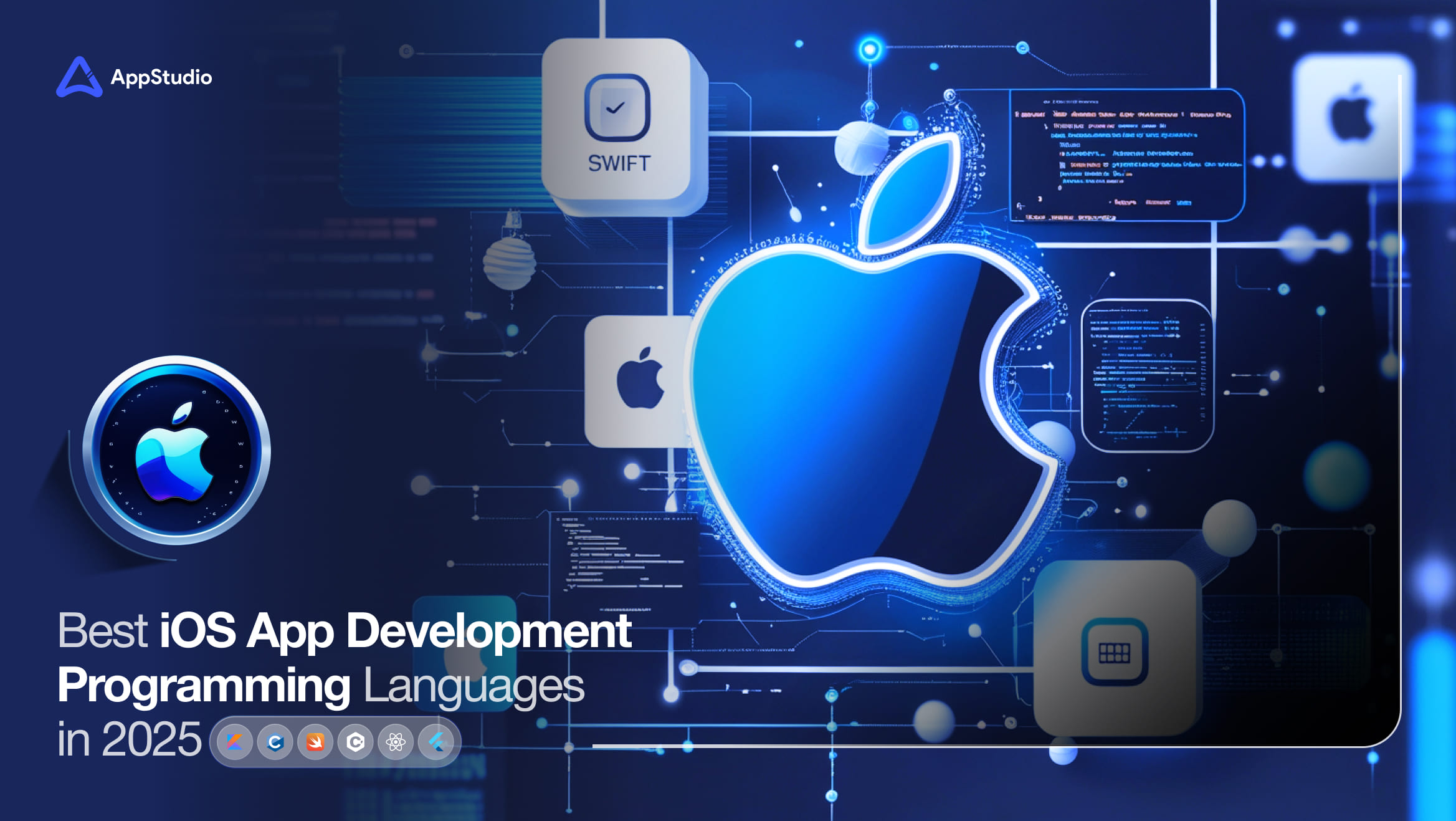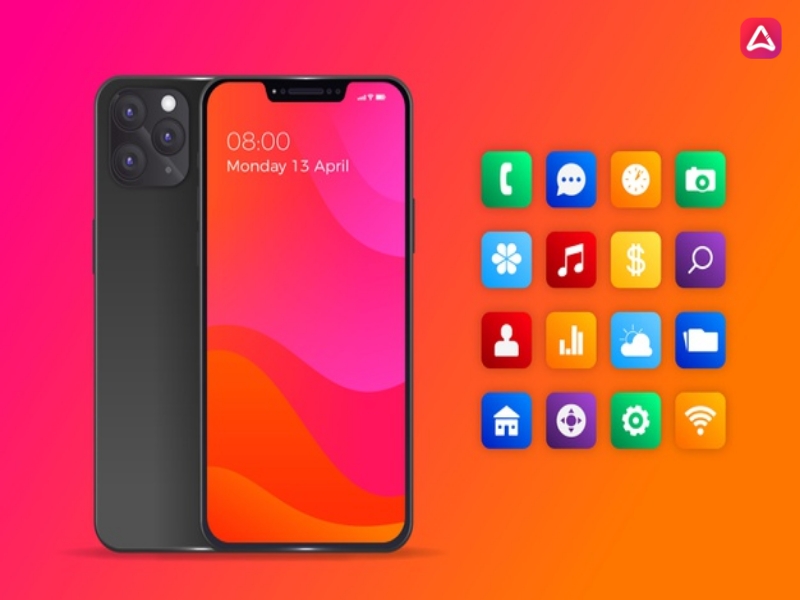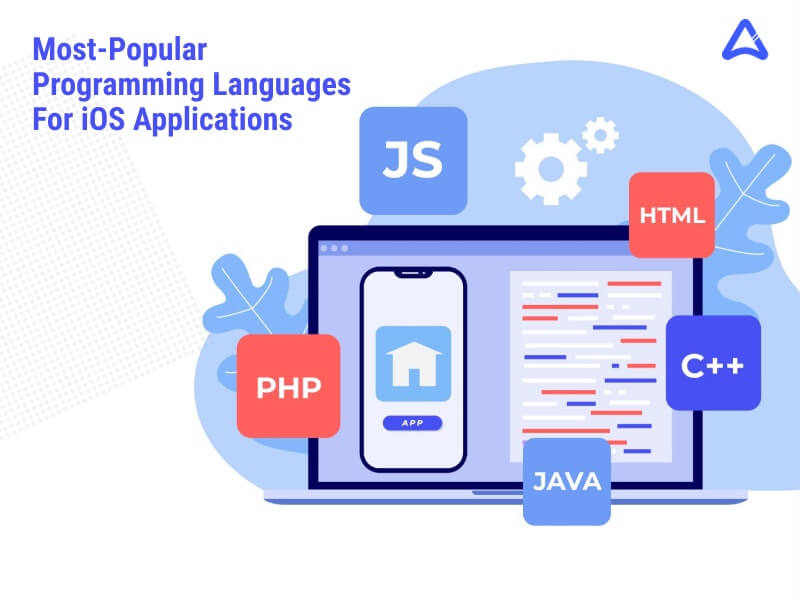As we step into 2025, the digital landscape continues to evolve, profoundly shaping our interactions with the world. A staggering statistic shows that by the end of 2024, over 4.48 billion people worldwide are expected to utilize mobile internet. Among these, approximately 1.46 billion will be active iPhone users, marking a significant presence in the mobile market. This vast user base underscores the critical importance of iOS app development and highlights the need to choose the best programming language for iOS app development to stay competitive.
With over 1.836 million apps on the Apple App Store, developers have a lucrative opportunity to tap into this thriving market. Understanding and mastering the best programming language for iOS app development is essential to creating apps that meet user demands and stand out in the market. At Appstudio, we recognize this potential and are committed to equipping you with the tools and knowledge to succeed. By leveraging our expertise and the programming language for iOS app development, we ensure you can make the most of this dynamic platform and achieve success in your projects.
Now, let’s get started together!
Related reading: iOS App Development Tools for iPhone Apps
iOS App Development Languages: What You Need to Know
The importance of iOS app development for businesses is increasingly evident. Apps designed for Apple devices enable businesses to meet market demands, understand competitors, and broaden their reach in the mobile domain. With a variety of iOS programming languages available, developers can create a diverse array of mobile applications that are compatible with Apple products, enhancing the app ecosystem and providing new ways for businesses to connect with their audience. Choosing the best programming language for iOS app development is essential to ensure these apps deliver exceptional performance and functionality.
Whether through native iOS apps or cross-platform solutions, the iOS app development field offers vast innovation opportunities. A deep understanding of the best programming language for iOS app development and the right tools is crucial for success. iOS app development is a cornerstone of mobile software creation, known for its strong performance and rigorous security standards. It offers a seamless user experience and serves as a profitable platform for developers eager to introduce innovative applications. At Appstudio, we specialize in the language used for iPhone app development, honing our skills to master the intricacies of iOS development. Our expertise enables us to transform your innovative ideas into reality, crafting unique apps that captivate users and stand out in the competitive market.
Why Choose iOS App Development?
Choosing iOS for app development offers substantial advantages that are attractive to both businesses and developers. As Steve Jobs once said, “Innovation distinguishes between a leader and a follower.” This ethos is deeply embedded in iOS app development, where the platform continues to lead with its innovative approach to app functionality and user engagement. iOS apps provide a compelling revenue model with multiple revenue streams, including subscriptions, ads, and in-app purchases.
This diverse range of monetization strategies leads to a substantial return on investment, making iOS a profitable choice for companies. By utilizing the iPhone app development programming language, developers can create high-quality applications that maximize these revenue opportunities. Understanding the right programming languages to develop iOS apps is essential to ensure apps are optimized for the platform’s capabilities. The platform’s robust ecosystem supports developers in building applications that thrive financially and enhance user experience.
Moreover, iOS boasts significant market penetration, which enables businesses to use iOS apps to broaden their international presence. With its global reach, companies can explore new markets and possibilities, extending their influence beyond traditional boundaries. The reliability and widespread adoption of iOS makes it an ideal platform for targeting a diverse and expansive user base. Developers with a solid grasp of iOS app development programming languages can make the best of this market and ensure their applications are cutting-edge.
iOS app development ensures a safer platform by reducing threats like phishing and hacking, thereby increasing transaction security for both users and developers. The heightened security measures of iOS safeguard sensitive user data and enhance trust, which is crucial in today’s digital world, where data breaches and security threats are increasingly common. By mastering iOS app development programming languages, app developers can also build secure, user-friendly apps that align with Apple’s stringent security standards. These attributes make iOS a favored option for app development, emphasizing the need to master programming languages to develop iOS apps. By harnessing the power of iOS, developers can deliver superior apps that stand out in the competitive market, ensuring both innovation and security are at the forefront of their offerings.
Related reading: Top 10 iOS App Development Companies In Canada
7 Best Programming Languages for iOS App Development
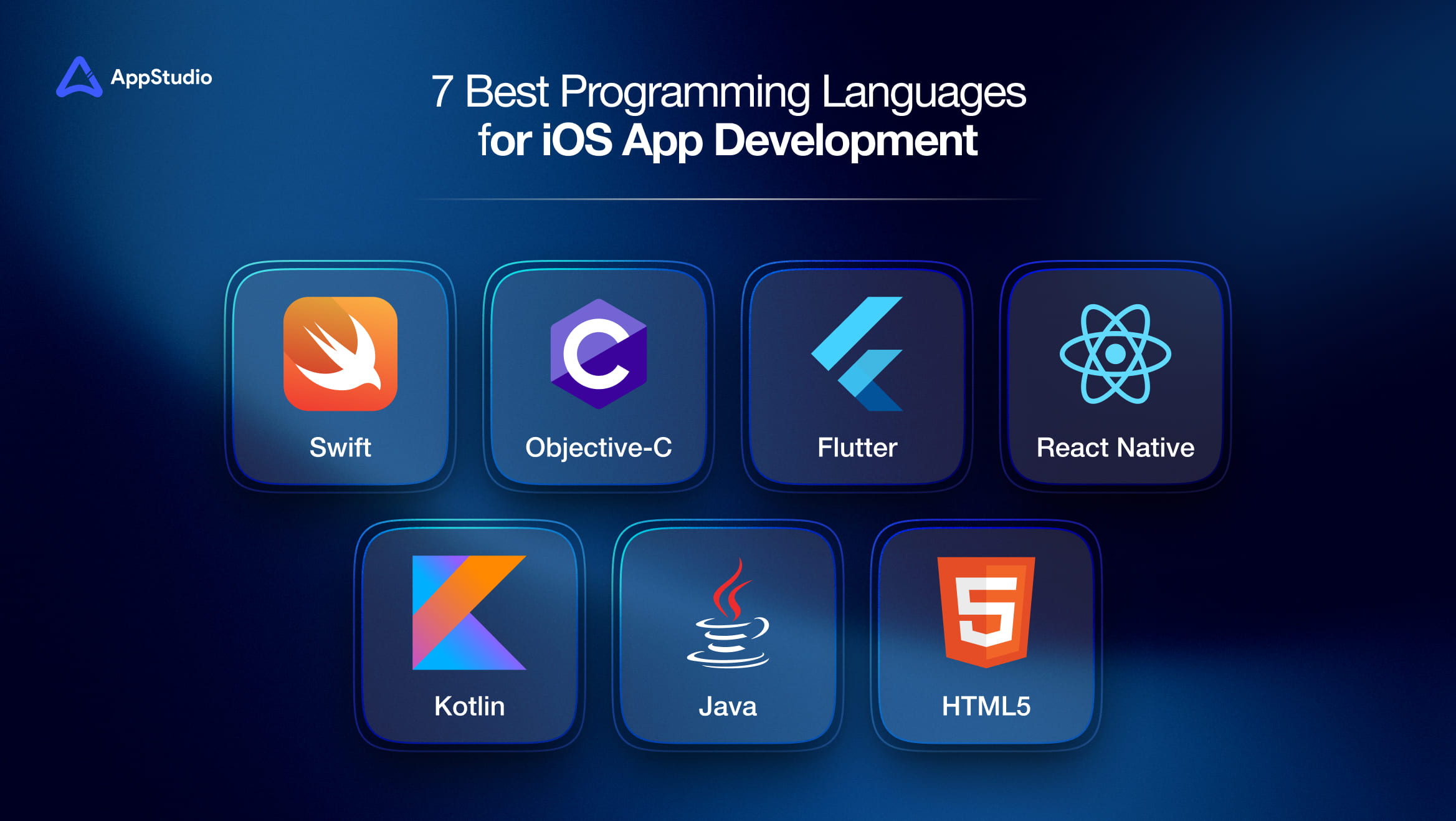
Navigating the landscape of iOS app development? Here’s a detailed overview of seven pivotal iOS programming languages and their benefits and limitations.
Swift
Swift, developed by Apple in 2014 as a modern replacement for Objective-C, quickly became the preferred language for developers working across Apple’s platforms, including iOS. As one of the most prominent programming languages used to develop iOS apps, Swift offers a modern, efficient, and user-friendly approach that has revolutionized the development process for Apple’s ecosystem.
Advantages:
- Modern Syntax: The syntax in Swift is intuitive and streamlined, which facilitates quicker and more effective coding.
- Safety Features: Swift enhances code security by eliminating common errors that can lead to app crashes or security breaches.
- Performance: Engineered for speed, Swift’s performance rivals that of C thanks to its optimized memory handling.
- Interoperability: Swift works seamlessly with Objective-C, allowing easy integration into existing projects.
- Open Source: As an open-source language, Swift benefits from a broad community of ios developers who contribute to its ongoing enhancement.
Challenges:
- Learning Curve: Beginners may initially struggle with Swift’s advanced features.
- ABI Stability Issues: Past issues with ABI stability have necessitated frequent updates to maintain compatibility.
- Tooling and Ecosystem: While growing, the range of available tools and libraries is not as extensive as that for some older languages.
- Compile Times: Larger projects may experience slower compile times, which can impact development efficiency.
Examples:
- Amazon’s Alexa
- Lyft
- YouTube
- Google Pay
Objective-C
Objective-C has been a core programming language used to develop iOS apps and Mac applications since the 1980s. It is known for its deep integration with Apple’s ecosystem. Its longevity and robust compatibility have made it a cornerstone in Apple’s development history.
Advantages:
- Established Ecosystem: A wealth of libraries and frameworks are available thanks to decades of development and optimization.
- Cocoa Compatibility: Objective-C integrates flawlessly with Cocoa and Cocoa Touch, Apple’s native frameworks.
- Dynamic Messaging: This feature enables highly flexible code, which can be adjusted at runtime to meet varying application needs.
- Proven Track Record: The long-standing use of Objective-C has established a solid foundation of knowledge and developer support.
Challenges:
- Verbose Syntax: The syntax is more complex than Swift’s, which can slow development progress.
- Manual Memory Management: Developers need to manage memory manually, which can introduce errors if not handled carefully.
- Reduced Development Focus: Since the rise of Swift, fewer new resources have been devoted to Objective-C, though it remains supported.
Examples
- Apple Music
- Apple Maps
- Dropbox
- eBay
Flutter
Flutter, developed by Google, enables developers to build beautiful, natively compiled mobile, web, and desktop applications from a single codebase using Dart.
Advantages:
- Unified Codebase: Code once and apply your efforts across multiple platforms, significantly streamlining the development process.
- Rapid Development: The hot reload feature allows for real-time previews of changes, significantly speeding up the iteration process.
- Engaging User Interfaces: A wide array of customizable widgets are available to create distinctive and effective user interfaces.
- High Performance: Apps run as native code, which maximizes performance and fluidity.
Challenges:
- Evolving Libraries: The framework’s library system is expanding but isn’t as robust as those for older frameworks.
- Application Size: Apps tend to be larger, which could be problematic for devices with limited storage.
- Inconsistencies Across Platforms: Developing for multiple platforms can introduce specific bugs that need to be addressed uniquely.
Examples:
- MyBMW
- Hamilton: The Musical
- Xianyu by Alibaba
Related reading: Top Programming Languages for Mobile App Development
React Native
Meta’s React Native, often considered the best programming language for iOS app development, leverages JavaScript and React to enable the development of native apps for both iOS and Android from a single codebase.
Advantages:
- Cross-Platform Capability: Streamlines development by using one codebase for multiple platforms, reducing time and costs.
- Component Reusability: Enhances efficiency and consistency across projects by allowing components to be reused.
- Immediate Feedback: The hot reload feature facilitates immediate viewing of changes, enhancing developer productivity.
- Native-Like Performance: Delivers performance comparable to native apps, with access to native functionalities.
Challenges:
- Dependency on Native Code: Some features might still require native development, complicating the development process.
- Potential Performance Hiccups: High-demand visual tasks might not perform as well as on native apps.
- Bridge Communication: The bridge facilitating communication between JavaScript and native modules can sometimes slow down the app’s performance.
Examples:
- Walmart
- Bloomberg
Kotlin Multiplatform
Kotlin Multiplatform extends Kotlin’s reach from Android to iOS, allowing developers to share logic and data across platforms while maintaining high performance.
Advantages:
- Shared Logic: Enables consistent application logic across platforms, which reduces redundancy and enhances app integrity.
- Native Execution: Compiled directly to native binaries, it ensures applications run smoothly and efficiently.
- Flexible API Access: Developers can access specific platform APIs to optimize functionality without compromising the shared code base.
Challenges:
- Relative Novelty: Being relatively new, Kotlin Multiplatform is still developing its ecosystem, which may lack certain functionalities.
- Specific Platform Code Needed: Some aspects of the app may still require platform-specific coding, which can add complexity.
- Development Tools Support: While improving, the support in IDEs and build systems might not be as comprehensive as for purely native development environments.
Examples:
- Careem
- Trello
- VMware Workspace ONE
Java
Once the backbone of dynamic web and enterprise applications, Java now also facilitates iOS app development through various interoperability techniques.
Advantages:
- Code Reusability: Leverage existing Java codebases for iOS development.
- Cross-Platform Compatibility: Frameworks support development across multiple platforms.
- Familiarity: Utilizes established Java skills.
Disadvantages:
- Limited Native Experience: This may not fully conform to iOS user experience standards.
- Compatibility Issues: Keeping up with the latest iOS features can be challenging.
Examples:
- Netflix
- Microsoft Office Apps
- Amazon Kindle
- Spotify
HTML5
Using frameworks like PhoneGap, HTML5 allows developers to create apps for iOS using standard web technologies. As one of the top programming languages for iOS app development in the web category, HTML5 enables developers to leverage familiar tools like HTML, CSS, and JavaScript for cross-platform compatibility.
Advantages:
- Cross-Platform Compatibility: Facilitates development across multiple platforms.
- Rapid Prototyping: Quick testing and refinement of app ideas.
- Familiar Technologies: Utilizes well-known web standards like HTML, CSS, and JavaScript.
Disadvantages:
- User Experience: This may not match the performance of native apps.
- Offline Functionality: Less control over device resources compared to native applications.
Examples:
- PhoneGap
- Uber Eats
- Starbucks
- Cordova
Related reading: Top Mobile App Development Tools
4 Key Factors for Choosing an iOS Programming Language
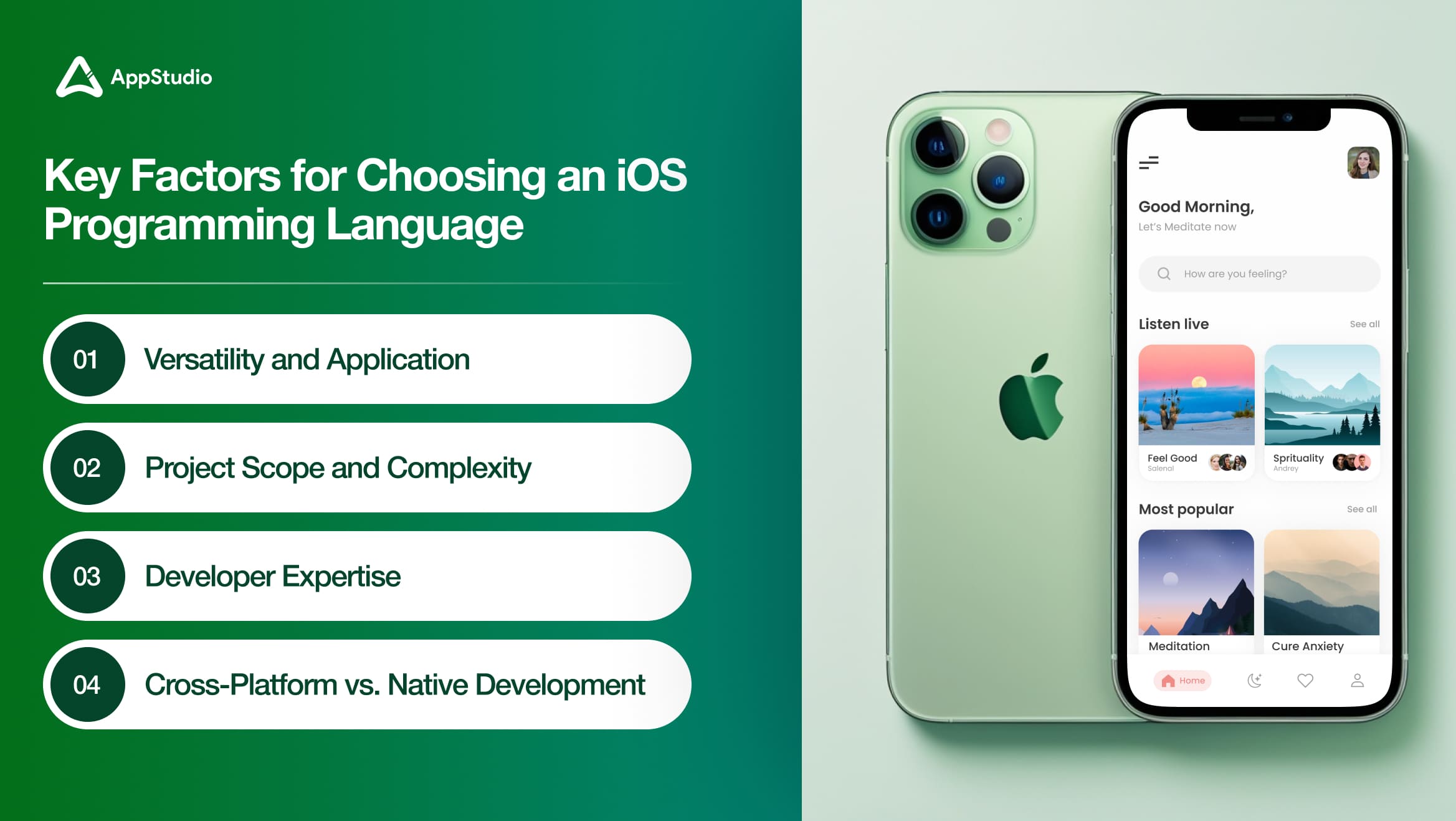
Choosing the correct iOS programming language involves assessing various critical factors, including the project’s scope, complexity, and the skill level of your development team. This decision is pivotal as it needs to meet the app’s functional needs and align with the business’s strategic objectives while ensuring compatibility with the iOS operating system for a smooth development journey.
Versatility and Application
The flexibility of a programming language is crucial as it determines the breadth of applications it can support in mobile app development. A highly versatile language can adapt to a wide range of development scenarios, making it a preferred choice for developers.
Project Scope and Complexity
The nature and complexity of the project greatly influence the choice of programming language. For applications that require intense data processing or advanced features, native development languages are typically favored. Key considerations in selecting a programming language include:
- The development team’s familiarity and proficiency with the language.
- The scalability potential of the app.
- The robustness of the language’s support community and ecosystem.
- Compatibility with various iOS versions.
Considering these elements ensures the app reaches a wide audience and provides a consistent user experience across different devices.
Developer Expertise
The development team’s skill set is another crucial factor in choosing a programming language for iOS. A team’s expertise with a specific language can expedite project timelines and enhance the quality of the final code. For those new to iOS development, Swift is often recommended due to its ease of use and comprehensive learning resources, like Swift Playgrounds, which help make the learning curve more manageable.
Cross-Platform vs. Native Development
Deciding between cross-platform and native development is vital and depends on the project’s specific needs. Native development is generally required for high-performance applications with complex functionalities. Conversely, cross-platform development can expedite deployment and expand reach using a single codebase to cover multiple platforms.
The productivity and maintenance speed in both cross-platform and native development are contingent on having the right development tools and a supportive integrated development environment (IDE). The choice of programming language should thus also reflect its ability to handle extensive user loads efficiently without compromising performance.
These considerations are integral to selecting an iOS programming language that meets technical requirements and supports broader business goals and user engagement strategies.
Related reading: Mobile App Development Cost
Best Language for iPhone App Development & Its Trends
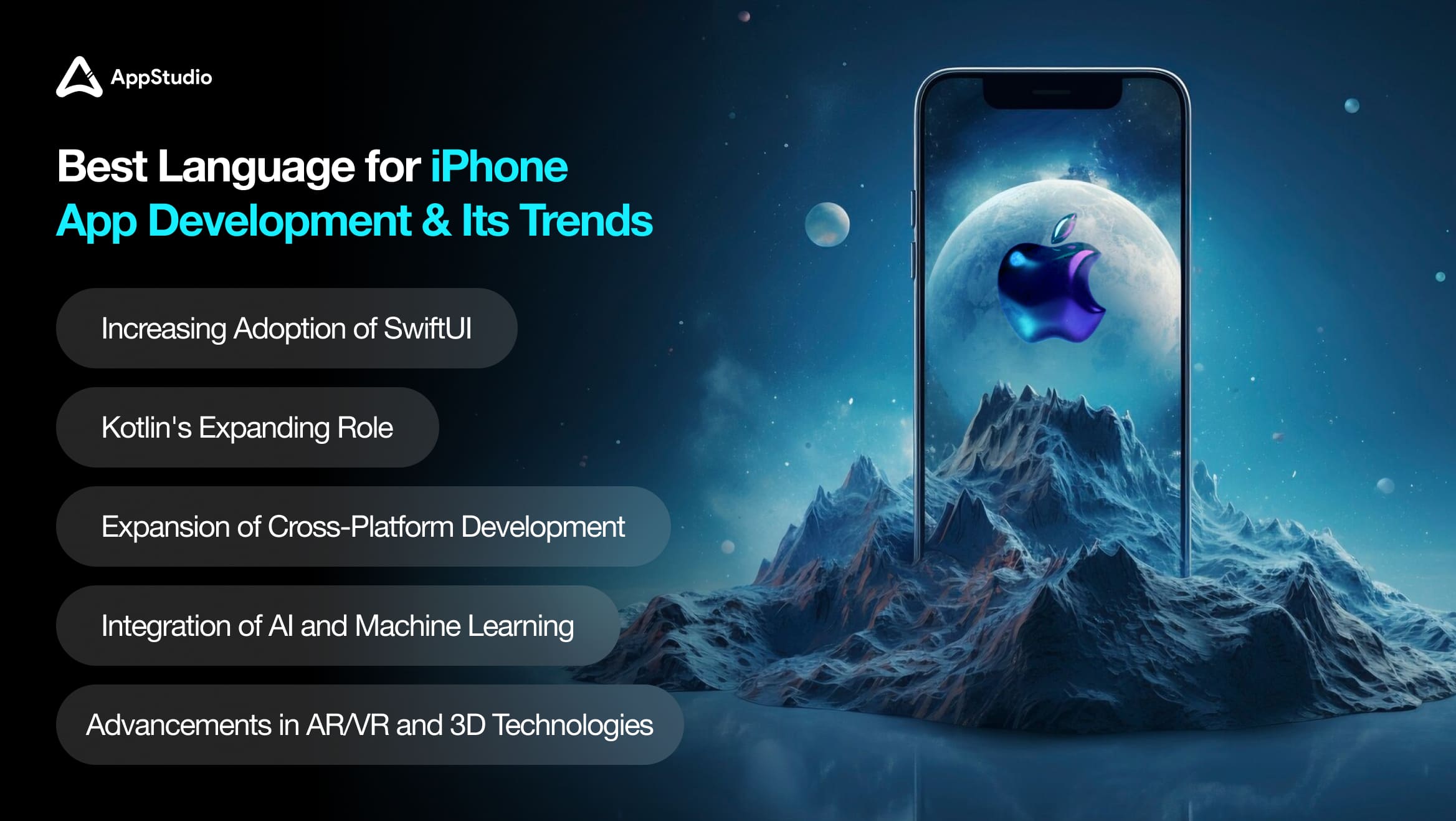
The landscape of iOS app development is poised for exciting transformations, driven by advancements in cross-platform capabilities and the integration of AI and machine learning technologies. These innovations are paving the way for developers to create more intuitive, efficient, and sophisticated applications.
Increasing Adoption of SwiftUI
Apple’s SwiftUI is rapidly becoming the go-to framework for developing iOS applications. As an essential tool alongside the iPhone app development language Swift, it reduces the amount of code required while enhancing the flexibility of user interfaces, making it increasingly popular. As more developers adopt Swift, the use of SwiftUI is expected to rise, facilitating the creation of compatible applications across various Apple devices, from iPhones to Apple Watches.
Integration of AI and Machine Learning
Personalization is becoming a cornerstone of app development, necessitating the incorporation of AI capabilities such as Apple’s Core ML into iOS applications. By 2025, it is anticipated that AI features, including predictive typing, intelligent recommendations, and facial recognition, will be standard in iOS app development, enhancing user engagement through personalized experiences.
Expansion of Cross-Platform Development
Tools like Flutter and React Native enable developers to build applications that function seamlessly on iOS and Android platforms. As businesses aim to cut costs and accelerate time to market, these cross-platform frameworks are expected to become even more prevalent. The continued support for programming languages such as Dart and JavaScript will further fuel this trend.
Advancements in AR/VR and 3D Technologies
With Apple’s continuous investment in augmented reality (AR) via ARKit, iOS applications are increasingly leveraging AR and virtual reality (VR) to deliver immersive user experiences. These technologies are revolutionizing the way users interact with digital content in various sectors, including retail, education, and gaming.
Kotlin’s Expanding Role
Kotlin Multiplatform is making strides in cross-platform development by allowing developers to share business logic across iOS and Android platforms. Although its ecosystem is currently smaller compared to that of React Native or Flutter, Kotlin is gaining traction and becoming a favored option for developers who primarily work on Android and are looking to expand their reach into iOS development.
These trends indicate a dynamic future for iOS app development, characterized by technological integration and innovative app design and functionality approaches.
Advancing iOS Mobile App Development Language with Modern Techniques
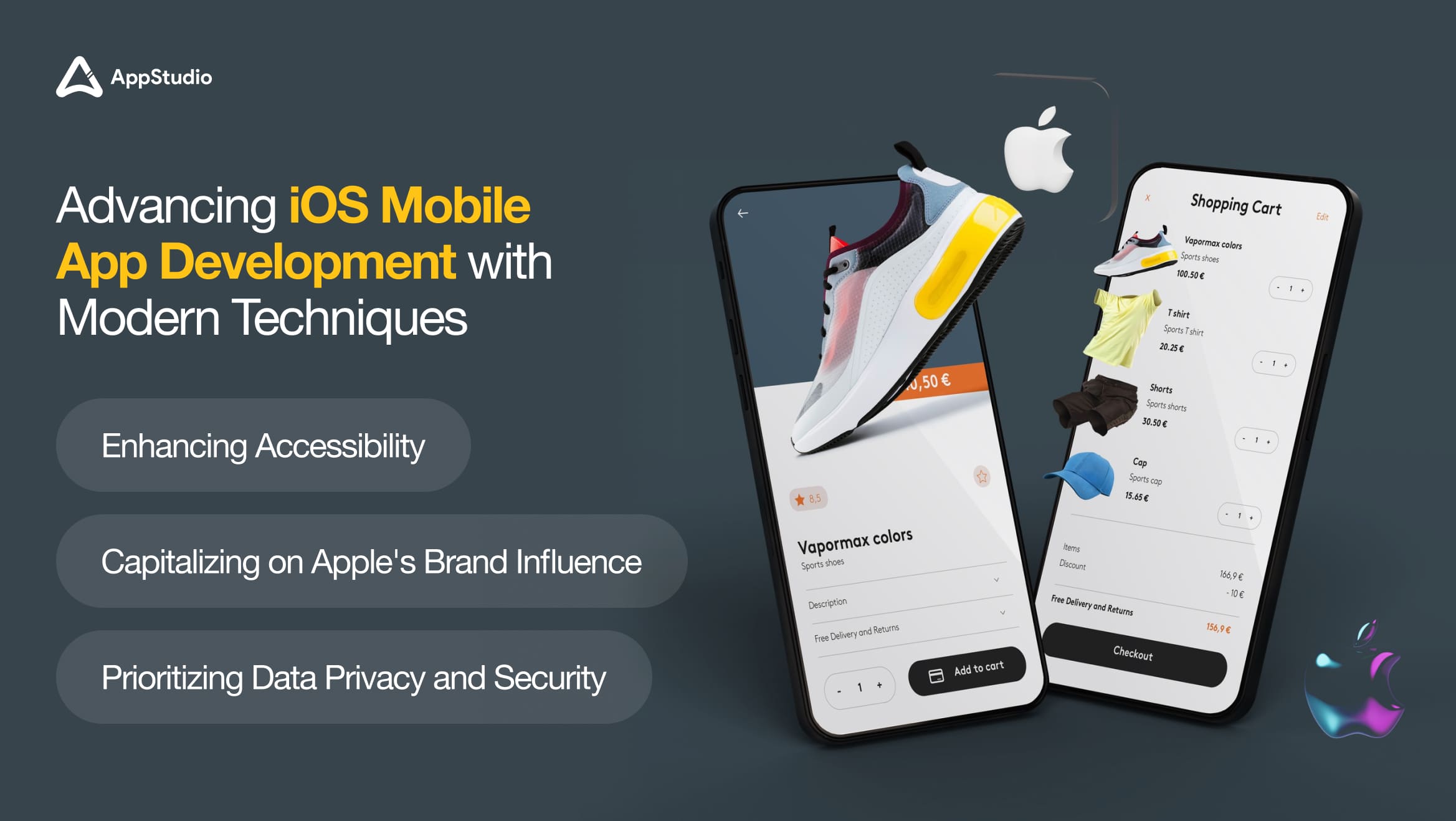
Developing an iOS app goes beyond simply selecting an appropriate programming language. It involves a series of vital steps and considerations that can significantly refine both the development process and the quality of the final product. By integrating advanced techniques such as enhancing accessibility, capitalizing on Apple’s brand influence, and emphasizing data privacy and security, developers can elevate the user experience and ensure their apps meet the latest digital standards and trends. Below, we delve into these techniques and their practical applications in iOS app development.
Enhancing Accessibility
Ensuring inclusivity is crucial for the success of any application. Advanced accessibility features such as VoiceOver, Dynamic Type, and Assistive Touch enable iOS apps to cater to a broader audience, including those with disabilities. This approach expands the potential user base and engagement and fosters innovation that can benefit all users. Integrating comprehensive accessibility testing within the app development lifecycle is vital to ensure that the app is functional and friendly for users with diverse needs.
Capitalizing on Apple’s Brand Influence
Aligning your app’s design with Apple’s renowned interface standards can significantly boost download rates due to its enhanced user experience. Apple is synonymous with intuitive design and sleek aesthetics, setting a high standard in the tech industry. By mirroring Apple’s design principles, apps can achieve a more seamless integration into the iOS ecosystem, thereby building stronger customer relationships and gaining a competitive edge on the App Store.
Prioritizing Data Privacy and Security
In today’s digital landscape, data privacy and security are paramount. Adhering to Apple’s strict security protocols, such as the App Tracking Transparency framework and privacy labels, protects user data and aligns with global privacy standards. iOS devices offer robust security against threats like malware and viruses, positioning them as a safer choice for users concerned about data privacy. Developers that incorporate these privacy features provide users with transparent data usage and control, enhancing trust and compliance.
Related reading: Complete Guide to Application Development Life Cycle
How AppStudio’s Experts Leverage the Best Programming Languages for Your iOS App Project
At AppStudio, we specialize in creating exceptional iOS apps with a team of skilled developers proficient in top programming languages for iOS app development like Swift and Objective-C. Our expertise ensures smooth functionality and an outstanding user experience. Whether you need a native iOS app or a cross-platform solution using tools like Kotlin Multiplatform, we tailor our approach to meet your unique needs. By leveraging the latest tools and adhering to Apple’s best practices, we craft apps that stand out in today’s competitive market.
In the ever-changing world of iOS app development, staying ahead demands expertise in the modern language used for iOS app development and advanced techniques. With mobile internet usage continuously rising, iOS offers a secure, user-friendly platform that provides businesses and developers immense opportunities to innovate and grow. By focusing on user privacy, Apple’s robust ecosystem, and cutting-edge technologies, developers can build superior apps that meet the needs of today’s digital users.
Let AppStudio help turn your ideas into reality. If you’re ready to embark on your iOS development journey, contact us today to explore how we can drive your success.
Frequently Asked Questions
An iOS app is software developed for Apple’s iOS platform and designed to run on Apple’s mobile devices, including iPhones and iPads.
iOS apps are primarily written in Swift and Objective-C, with Swift being the most favored due to its robust features and ease of use.
The development time for an iOS app can vary widely depending on its complexity, features, and the developer’s expertise, typically ranging from several weeks to several months.
At AppStudio, we pride ourselves on our cutting-edge technology, deep expertise in the language used for iOS app development, and proven track record of delivering high-quality, innovative iOS applications that exceed client expectations.
We’ve developed a wide range of iOS apps, from AR-enabled shopping experiences to AI-powered educational tools, showcasing our versatility and innovation in app development. Our expertise in the language for developing iOS apps enhances our ability to create cutting-edge solutions tailored to our clients’ needs.
We consistently invest in training and implementing the latest technologies, frameworks, and best practices, focusing on mastering the best language for iOS app development to deliver cutting-edge and effective app solutions to our clients.
